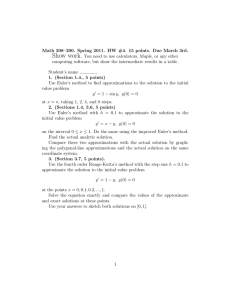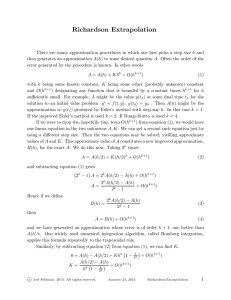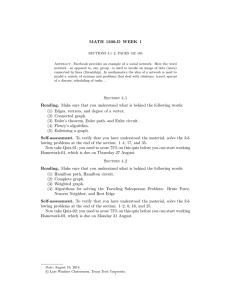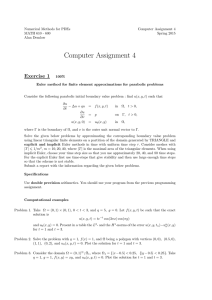Simple ODE Solvers - Derivation
advertisement
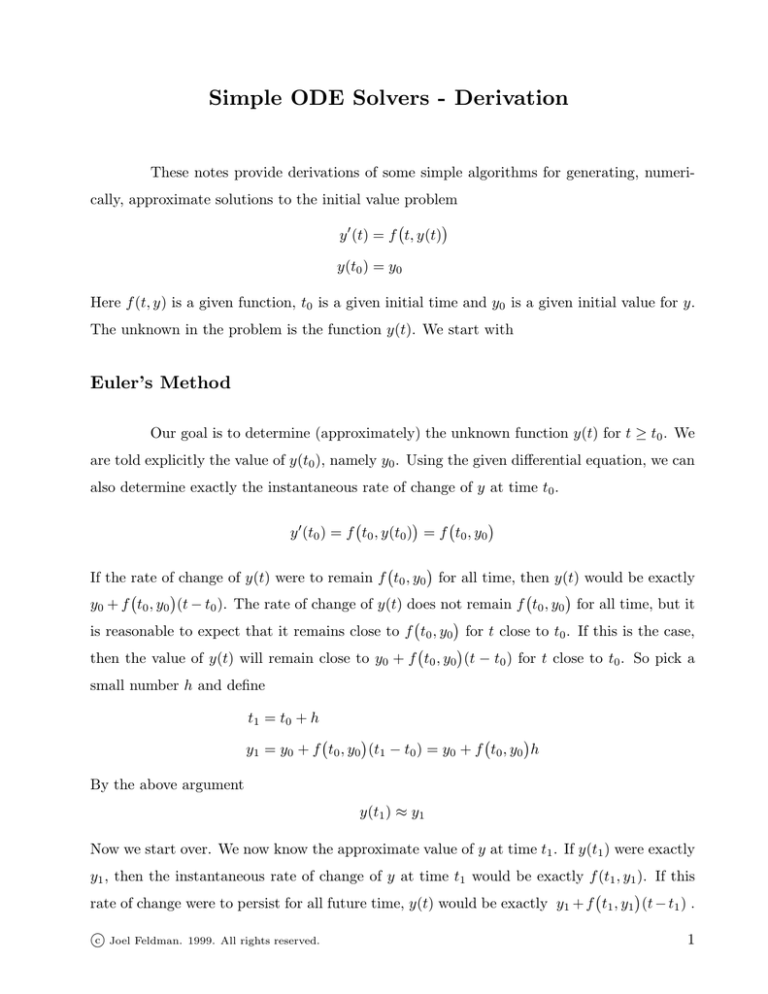
Simple ODE Solvers - Derivation These notes provide derivations of some simple algorithms for generating, numerically, approximate solutions to the initial value problem y ′ (t) = f t, y(t) y(t0 ) = y0 Here f (t, y) is a given function, t0 is a given initial time and y0 is a given initial value for y. The unknown in the problem is the function y(t). We start with Euler’s Method Our goal is to determine (approximately) the unknown function y(t) for t ≥ t0 . We are told explicitly the value of y(t0 ), namely y0 . Using the given differential equation, we can also determine exactly the instantaneous rate of change of y at time t0 . y ′ (t0 ) = f t0 , y(t0 ) = f t0 , y0 If the rate of change of y(t) were to remain f t0 , y0 for all time, then y(t) would be exactly y0 + f t0 , y0 (t − t0 ). The rate of change of y(t) does not remain f t0 , y0 for all time, but it is reasonable to expect that it remains close to f t0 , y0 for t close to t0 . If this is the case, then the value of y(t) will remain close to y0 + f t0 , y0 (t − t0 ) for t close to t0 . So pick a small number h and define t1 = t0 + h y1 = y0 + f t0 , y0 (t1 − t0 ) = y0 + f t0 , y0 h By the above argument y(t1 ) ≈ y1 Now we start over. We now know the approximate value of y at time t1 . If y(t1 ) were exactly y1 , then the instantaneous rate of change of y at time t1 would be exactly f (t1 , y1 ). If this rate of change were to persist for all future time, y(t) would be exactly y1 + f t1 , y1 (t − t1 ) . c Joel Feldman. 1999. All rights reserved. 1 As y(t1 ) is only approximately y1 and as the rate of change of y(t) varies with t, the rate of change of y(t) is only approximately f (t1 , y1 ) and only for t near t1 . So we approximate y(t) by y1 + f t1 , y1 (t − t1 ) for t bigger than, but close to, t1 . Defining t2 = t1 + h = t0 + 2h y2 = y1 + f t1 , y1 (t2 − t1 ) = y1 + f t1 , y1 h we have y(t2 ) ≈ y2 We just repeat this argument ad infinitum. Define, for n = 0, 1, 2, 3, · · · tn = t0 + nh Suppose that, for some value of n, we have already computed an approximate value yn for y(tn ). Then the rate of change of y(t) for t close to tn is f t, y(t) ≈ f tn , y(tn ) ≈ f tn , yn and, again for t close to tn , y(t) ≈ yn + f tn , yn (t − tn ). Hence y(tn+1 ) ≈ yn+1 = yn + f tn , yn h (Eul) This algorithm is called Euler’s Method. The parameter h is called the step size. Here is a table applying a few steps of Euler’s method to the initial value problem y ′ = −2t + y y(0) = 3 with step size h = 0.1. For this initial value problem f (t, y) = −2t + y t0 = 0 y0 = 3 Of course this initial value problem has been chosen for illustrative purposes only. The exact solution is, easily, y(t) = 2 + 2t + et . n tn yn f (tn , yn ) = −2tn + yn yn+1 = yn + f (tn , yn ) ∗ h 0 0.0 3.000 −2 ∗ 0.0 + 3.000 = 3.000 3.000 + 3.000 ∗ 0.1 = 3.300 1 2 3 0.1 0.2 0.3 3.300 3.610 3.931 −2 ∗ 0.1 + 3.300 = 3.100 −2 ∗ 0.2 + 3.610 = 3.210 −2 ∗ 0.3 + 3.931 = 3.331 3.300 + 3.100 ∗ 0.1 = 3.610 3.610 + 3.210 ∗ 0.1 = 3.931 3.931 + 3.331 ∗ 0.1 = 4.264 4 5 0.4 0.5 4.264 4.611 −2 ∗ 0.4 + 4.264 = 3.464 4.264 + 3.464 ∗ 0.1 = 4.611 c Joel Feldman. 1999. All rights reserved. 2 The Improved Euler’s Method Euler’s method is one algorithm which generates approximate solutions to the initial value problem y ′ (t) = f t, y(t) y(t0 ) = y0 In applications, f (t, y) is a given function and t0 and y0 are given numbers. The function y(t) is unknown. Denote by ϕ(t) the exact solution for this initial value problem. In other words ϕ(t) is the function that obeys ϕ′ (t) = f t, ϕ(t) ϕ(t0 ) = y0 exactly. Fix a step size h and define tn = t0 + nh. We now derive another algorithm that generates approximate values for ϕ at the sequence of equally spaced time values t0 , t1 , t2 , · · ·. We shall denote the approximate values yn with yn ≈ ϕ(tn ) By the fundamental theorem of calculus and the differential equation, the exact solution obeys ϕ(tn+1 ) = ϕ(tn ) + Z = ϕ(tn ) + Z tn+1 ϕ′ (t) dt tn tn+1 f t, ϕ(t) dt tn Fix any n and suppose that we have already found y0 , y1 , · · · , yn . Our algorithm for computing yn+1 will be of the form yn+1 = yn + approximate value for Z tn+1 f t, ϕ(t) dt tn In fact Euler’s method is of precisely this form. In Euler’s method, we approximate f t, ϕ(t) for tn ≤ t ≤ tn+1 by the constant f tn , yn . Thus Euler’s approximate value for Z tn+1 tn c Joel Feldman. 1999. All rights reserved. f t, ϕ(t) dt = Z tn+1 tn f tn , yn dt = f tn , yn h 3 The area of the complicated region 0 ≤ y ≤ f t, ϕ(t) , tn ≤ t ≤ tn+1 (represented by the shaded region under the parabola in the left half of the figure below) is approximated by the area of the rectangle 0 ≤ y ≤ f tn , yn , tn ≤ t ≤ tn+1 (the shaded rectangle in the right half of the figure below). f tn , ϕ(tn ) f tn , y n f t, ϕ(t) tn f tn , ϕ(tn ) f tn , y n f t, ϕ(t) tn tn+1 tn+1 Our second algorithm, the improved Euler’s method, gets a better approximation by attempting to approximate by the trapezoid on the right below rather than the rectangle on the right above. f tn+1 , ϕ(tn+1 ) f tn , ϕ(tn ) The exact area of this trapezoid is the length h of the base multiplied f t, ϕ(t) f tn+1 , ϕ(tn+1 ) f tn , ϕ(tn ) f t, ϕ(t) tn tn+1 by the average, 12 [f tn , ϕ(tn ) + f tn+1 , ϕ(tn+1 ) ], of the heights of the two sides. Of course tn tn+1 we do not know ϕ(tn ) or ϕ(tn+1 ) exactly. Recall that we have already found y0 , · · · , yn and are in the process of finding yn+1 . So we already have an approximation for ϕ(tn ), namely yn , but not for ϕ(tn+1 ). Improved Euler uses ϕ(tn+1 ) ≈ ϕ(tn ) + ϕ′ (tn )h ≈ yn + f (tn , yn )h in approximating 12 [f tn , ϕ(tn ) + f tn+1 , ϕ(tn+1 ) ]. Altogether Z tn+1 Improved Euler’s approximate value for f t, ϕ(t) dt tn h i = 12 f tn , yn + f tn+1 , yn + f (tn , yn )h h so that the improved Euler’s method algorithm is h i y(tn+1 ) ≈ yn+1 = yn + 21 f tn , yn + f tn+1 , yn + f (tn , yn )h h c Joel Feldman. 1999. All rights reserved. (ImpEul) 4 Here are the first two steps of the improved Euler’s method applied to y ′ = −2t + y y(0) = 3 with h = 0.1. In each step we compute f (tn , yn ), followed by yn +f (tn , yn )h, which we denote ỹn+1 , followed by f (tn+1 , ỹn+1 ), followed by yn+1 = yn + 21 f tn , yn + f tn+1 , ỹn+1 h. t0 = 0 y0 = 3 =⇒ f (t0 , y0 ) = −2 ∗ 0 + 3 = 3 =⇒ =⇒ ỹ1 = 3 + 3 ∗ 0.1 = 3.3 f (t1 , ỹ1 ) = −2 ∗ 0.1 + 3.3 = 3.1 y1 = 3 + 12 [3 + 3.1] ∗ 0.1 = 3.305 =⇒ t1 = 0.1 y1 = 3.305 =⇒ f (t1 , y1 ) = −2 ∗ 0.1 + 3.305 = 3.105 =⇒ =⇒ ỹ2 = 3.305 + 3.105 ∗ 0.1 = 3.6155 f (t2 , ỹ2 ) = −2 ∗ 0.2 + 3.6155 = 3.2155 y2 = 3.305 + 12 [3.105 + 3.2155] ∗ 0.1 = 3.621025 =⇒ Here is a table which gives the first five steps. n tn yn f (tn , yn ) ỹn+1 f (tn+1 , ỹn+1 ) yn+1 0 0.0 3.000 3.000 3.300 3.100 3.305 1 2 0.1 0.2 3.305 3.621 3.105 3.221 3.616 3.943 3.216 3.343 3.621 3.949 3 4 0.3 0.4 3.949 4.291 3.349 3.491 4.284 4.640 3.484 3.640 4.291 4.647 5 0.5 4.647 The Runge-Kutta Method The Runge-Kutta algorithm is similar to the Euler and improved Euler methods in that it also uses, in the notation of the last section, yn+1 = yn + approximate value for c Joel Feldman. 1999. All rights reserved. Z tn+1 tn f t, ϕ(t) dt 5 But rather than approximating R tn+1 tn f t, ϕ(t) dt by the area of a rectangle, as does Euler, or by the area of a trapezoid, as does improved Euler, it approximates by the area under a parabola. That is, it uses Simpson’s rule. According to Simpson’s rule (if you don’t know Simpson’s rule, just take my word for it) Z tn +h tn h i f t, ϕ(t) dt ≈ h6 f tn , ϕ(tn ) + 4f tn + h2 , ϕ(tn + h2 ) + f tn + h, ϕ(tn + h) As we don’t know ϕ(tn ), ϕ(tn + h2 ) or ϕ(tn + h), we have to approximate them as well. The Runge-Kutta algorithm, incorporating all these approximations, is kn,1 = f (tn , yn ) kn,2 = f (tn + 21 h, yn + h2 kn,1 ) kn,3 = f (tn + 21 h, yn + h2 kn,2 ) (RK) kn,4 = f (tn + h, yn + hkn,3 ) yn+1 = yn + h 6 [kn,1 + 2kn,2 + 2kn,3 + kn,4 ] Here are the first two steps of the Runge-Kutta algorithm applied to y ′ = −2t + y y(0) = 3 c Joel Feldman. 1999. All rights reserved. 6 with h = 0.1. t0 = 0 =⇒ =⇒ y0 = 3 k0,1 = f (0, 3) = −2 ∗ 0 + 3 = 3 y0 + h2 k0,1 = 3 + 0.05 ∗ 3 = 3.15 =⇒ k0,2 = f (0.05, 3.15) = −2 ∗ 0.05 + 3.15 = 3.05 =⇒ y0 + h2 k0,2 = 3 + 0.05 ∗ 3.05 = 3.1525 =⇒ =⇒ =⇒ =⇒ t1 = 0.1 =⇒ k0,3 = f (0.05, 3.1525) = −2 ∗ 0.05 + 3.1525 = 3.0525 y0 + hk0,3 = 3 + 0.1 ∗ 3.0525 = 3.30525 k0,4 = f (0.1, 3.30525) = −2 ∗ 0.1 + 3.30525 = 3.10525 y1 = 3 + 0.1 [3 6 + 2 ∗ 3.05 + 2 ∗ 3.0525 + 3.10525] = 3.3051708 y1 = 3.3051708 k1,1 = f (0.1, 3.3051708) = −2 ∗ 0.1 + 3.3051708 = 3.1051708 =⇒ y1 + h2 k1,1 = 3.3051708 + 0.05 ∗ 3.1051708 = 3.4604293 =⇒ k1,2 = f (0.15, 3.4604293) = −2 ∗ 0.15 + 3.4604293 = 3.1604293 =⇒ y1 + h2 k1,2 = 3.3051708 + 0.05 ∗ 3.1604293 = 3.4631923 =⇒ k1,3 = f (0.15, 3.4631923) = −2 ∗ 0.15 + 3.4631923 = 3.1631923 =⇒ =⇒ =⇒ y1 + hk1,3 = 3.3051708 + 0.1 ∗ 3.4631923 = 3.62149 k1,4 = f (0.2, 3.62149) = −2 ∗ 0.2 + 3.62149 = 3.22149 y2 = 3.3051708 + 0.1 6 [3.1051708 + 2 ∗ 3.1604293+ + 2 ∗ 3.1631923 + 3.22149] = 3.6214025 t2 = 0.2 y2 = 3.6214025 and here is a table giving the first five steps. The intermediate data is only given to three decimal places even though the computation has been done to many more. c Joel Feldman. 1999. All rights reserved. 7 n tn yn kn1 yn1 kn2 yn2 kn3 yn3 kn4 yn+1 0 0.0 3.000 3.000 3.150 3.050 3.153 3.053 3.305 3.105 3.305170833 1 0.1 3.305 3.105 3.460 3.160 3.463 3.163 3.621 3.221 3.621402571 2 0.2 3.621 3.221 3.782 3.282 3.786 3.286 3.950 3.350 3.949858497 3 0.3 3.950 3.350 4.117 3.417 4.121 3.421 4.292 3.492 4.291824240 4 0.4 4.292 3.492 4.466 3.566 4.470 3.570 4.649 3.649 4.648720639 5 0.5 4.648 These notes have, hopefully, motivated the Euler, improved Euler and Runge-Kutta algorithms. So far we not attempted to see how efficient and how accurate the algorithms are. A first look at those questions is provided in the notes “Simple ODE Solvers – Error Behaviour”. c Joel Feldman. 1999. All rights reserved. 8

